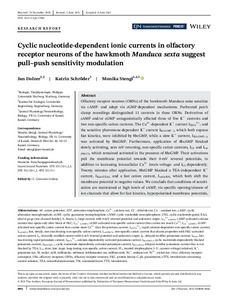| dc.date.accessioned | 2021-08-23T13:50:17Z | |
| dc.date.available | 2021-08-23T13:50:17Z | |
| dc.date.issued | 2021-06-14 | |
| dc.identifier | doi:10.17170/kobra-202108184575 | |
| dc.identifier.uri | http://hdl.handle.net/123456789/13154 | |
| dc.description.sponsorship | Gefördert im Rahmen des Projekts DEAL | ger |
| dc.language.iso | eng | eng |
| dc.rights | Attribution-NonCommercial-NoDerivatives 4.0 International | * |
| dc.rights.uri | http://creativecommons.org/licenses/by-nc-nd/4.0/ | * |
| dc.subject | cAMP | eng |
| dc.subject | cGMP | eng |
| dc.subject | insects | eng |
| dc.subject | metaplasticity | eng |
| dc.subject | olfactory transduction | eng |
| dc.subject.ddc | 570 | |
| dc.title | Cyclic nucleotide-dependent ionic currents in olfactory receptor neurons of the hawkmoth Manduca sexta suggest pull–push sensitivity modulation | eng |
| dc.type | Aufsatz | |
| dcterms.abstract | Olfactory receptor neurons (ORNs) of the hawkmoth Manduca sexta sensitize via cAMP- and adapt via cGMP-dependent mechanisms. Perforated patch clamp recordings distinguished 11 currents in these ORNs. Derivatives of cAMP and/or cGMP antagonistically affected three of five K+ currents and two non-specific cation currents. The Ca2+-dependent K+ current IK(Ca2+) and the sensitive pheromone-dependent K+ current IK(cGMP−), which both express fast kinetics, were inhibited by 8bcGMP, while a slow K+ current, IK(cGMP+), was activated by 8bcGMP. Furthermore, application of 8bcAMP blocked slowly activating, zero mV-reversing, non-specific cation currents, ILL and Icat(PKC?), which remained activated in the presence of 8bcGMP. Their activations pull the membrane potential towards their 0-mV reversal potentials, in addition to increasing intracellular Ca2+ levels voltage- and ILL-dependently. Twenty minutes after application, 8bcGMP blocked a TEA-independent K+ current, IK(noTEA), and a fast cation current, Icat(nRP), which both shift the membrane potential to negative values. We conclude that conditions of sensitization are maintained at high levels of cAMP, via specific opening/closure of ion channels that allow for fast kinetics, hyperpolarized membrane potentials, and low intracellular Ca2+ levels. In contrast, adaptation is supported via cGMP, which antagonizes cAMP, opening Ca2+-permeable channels with slow kinetics that stabilize depolarized resting potentials. The antagonistic modulation of peripheral sensory neurons by cAMP or cGMP is reminiscent of pull–push mechanisms of neuromodulation at central synapses underlying metaplasticity. | eng |
| dcterms.accessRights | open access | |
| dcterms.creator | Dolzer, Jan | |
| dcterms.creator | Schröder, Katrin | |
| dcterms.creator | Stengl, Monika | |
| dc.relation.doi | doi:10.1111/ejn.15346 | |
| dc.relation.projectid | Deutsche Forschungsgemeinschaft. Grant Numbers: STE 531/10-1,2,3, STE 531/20-1,2, STE 531/5-1 | |
| dc.subject.swd | Cyclo-AMP | ger |
| dc.subject.swd | Cyclo-GMP | ger |
| dc.subject.swd | Insekten | ger |
| dc.subject.swd | Geruchssinn | ger |
| dc.subject.swd | Manduca sexta | ger |
| dc.subject.swd | Tierphysiologie | ger |
| dc.type.version | publishedVersion | |
| dcterms.source.identifier | eissn:1460-9568 | |
| dcterms.source.issue | Issue 3 | |
| dcterms.source.journal | European Journal of Neuroscience (EJN) | eng |
| dcterms.source.pageinfo | 4804-4826 | |
| dcterms.source.volume | Volume 54 | |
| kup.iskup | false | |


